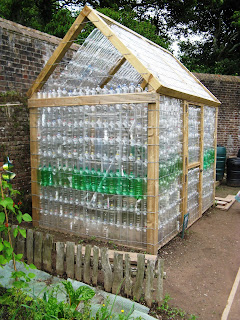Given the post about the enormous world-wide production of plastic bottles, it is heartening to read of a potential use for at least the 1.5 litre variety (https://www.theguardian.com/environment/2017/jun/30/house-tateh-built-sand-filled-recycled-waste-plastic-bottles-western-sahara-). It also reminded me of the UK greenhouse shown above that also uses old water bottles. An engineer called Tateh has utilised sand-filled plastic bottles to construct rounded (wind resistant) houses in a refugee camp in Algeria. The houses are painted white to reflect the Western Saharan heat and the material is reportedly more durable than traditional sun-dried bricks (there are occasional floods as well as the wind erosion). As it takes 6000 bottles to build a house, a rough calculation reveals that the world generates sufficient plastic bottles per minute to construct more than 150 such dwellings in desert locations. These houses could also have an associated greenhouse (also rounded?) and one could also probably produce viable structures in some sea-side locations.
This blog may help people explore some of the 'hidden' issues involved in certain media treatments of environmental and scientific issues. Using personal digital images, it's also intended to emphasise seasonal (and other) changes in natural history of the Swansea (South Wales) area. The material should help participants in field-based modules and people generally interested in the natural world. The views are wholly those of the author.
Friday, 30 June 2017
Have You Got the Bottle?
Given the post about the enormous world-wide production of plastic bottles, it is heartening to read of a potential use for at least the 1.5 litre variety (https://www.theguardian.com/environment/2017/jun/30/house-tateh-built-sand-filled-recycled-waste-plastic-bottles-western-sahara-). It also reminded me of the UK greenhouse shown above that also uses old water bottles. An engineer called Tateh has utilised sand-filled plastic bottles to construct rounded (wind resistant) houses in a refugee camp in Algeria. The houses are painted white to reflect the Western Saharan heat and the material is reportedly more durable than traditional sun-dried bricks (there are occasional floods as well as the wind erosion). As it takes 6000 bottles to build a house, a rough calculation reveals that the world generates sufficient plastic bottles per minute to construct more than 150 such dwellings in desert locations. These houses could also have an associated greenhouse (also rounded?) and one could also probably produce viable structures in some sea-side locations.
Subscribe to:
Post Comments (Atom)
-
I n the UK and US, a pparently popular and successful vegan/vegetarian restaurants are reportedly closing or adding meat to their menus ( ...
-
Early ripening fruit may seem convenient but some folk think it confirms environmental stress. There's also a possibility th...


%20mating%20NWCW.jpg)


No comments:
Post a Comment